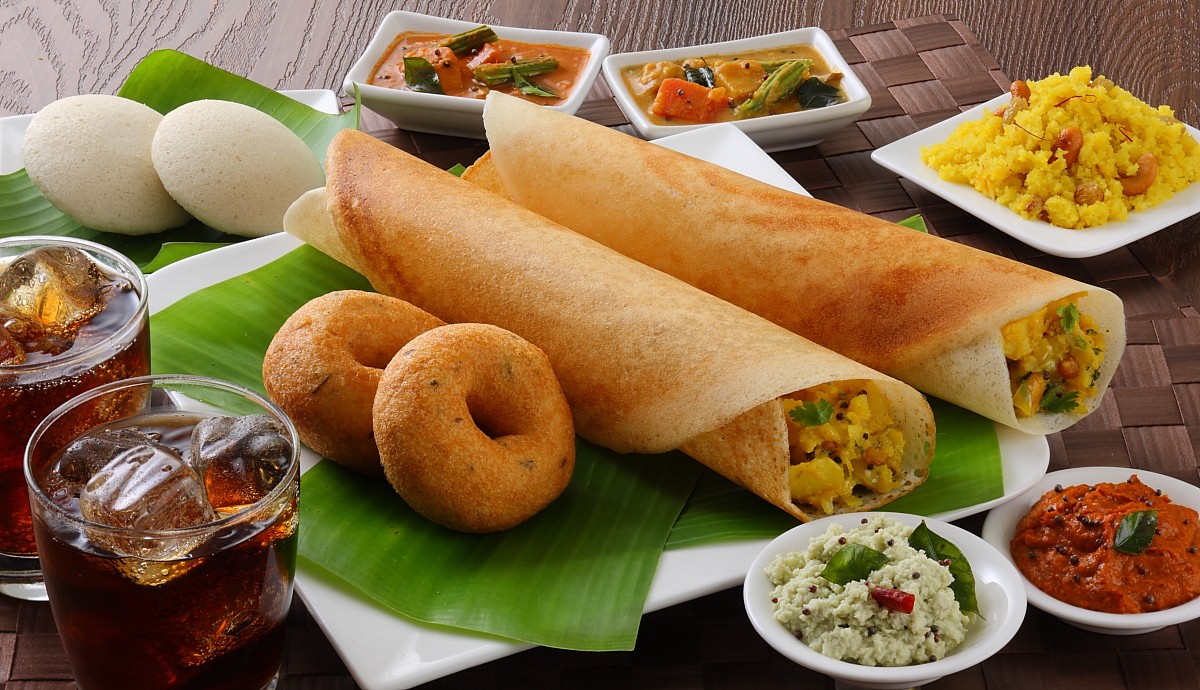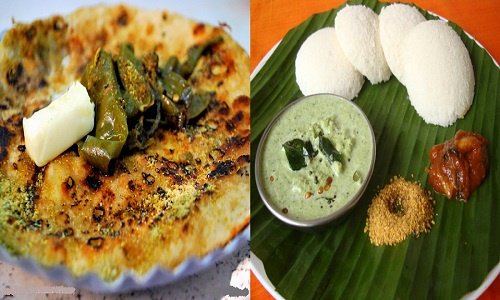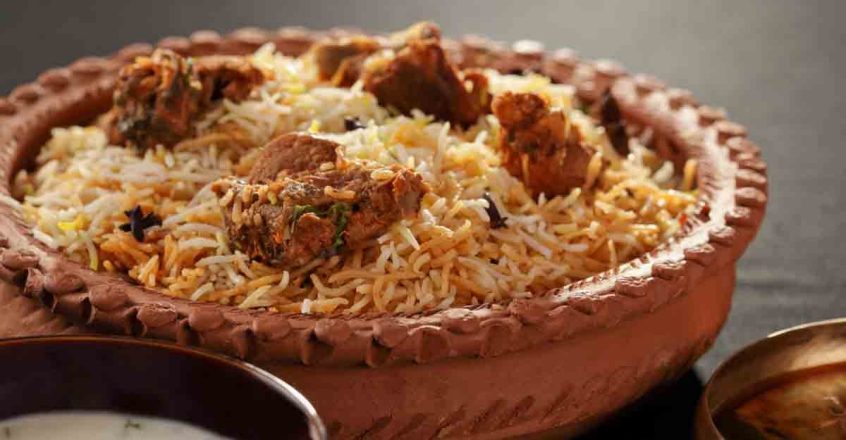Significant differences between North Indian and South Indian dishes

I adore Indian cuisine in all forms and have been eating it for decades. But I’m curious about the distinctions between Northern and Southern Indian cuisine.
Here’s what I’ve discovered after decades of admiration:
Southern Indian cuisine is more vegetarian and seafood-oriented than northern Indian cuisine, and it utilizes less ghee and more coconut milk. Dairy products, goat or chicken, and wheat-based bread items, such as naan bread, are standard in Northern Indian cuisine. Southern Indian cuisine, on the other hand, is spicier than Northern Indian cuisine.
India’s flavors are so diverse that it’s impossible to categorize Indian cuisine into a single category, just as it’s impossible to categorize American cuisine into a single category.
It all depends on where you live.
However, one region is recognized for its vegetarian cuisine, while another is the spiciest! Let’s take a closer look at what distinguishes these two locations in terms of their hallmark cuisine.
What does it mean to eat authentic south Indian food?
Dosa – a lentil and rice crepe, Idli – steamed lentil rice cakes, Saaru/Rasam – lentil, tamarind, and tomato soup, Huli/Sambar – a spicy lentil and vegetable stew, Vada – a crispy deep-fried lentil donut, and Kozhikode Biryani – chicken and rice with southern spices – are all popular south Indian dishes.
The climate in south India is more tropical than in north India.
This makes it an ideal location for growing rice, which is a mainstay in South Indian cuisine. Lentils are also a common ingredient in South Indian cuisine.
The consistency of southern curry is more saucy and runny, making it easy to pour over rice. They utilize a lot of coconut oil and milk in their dishes and cook with water.
Southern Indian cuisine has a unique spiciness, as well as bitterness or sourness on occasion.
Although both north and south Indian cuisines utilize many of the same spices, south Indian cuisine frequently uses the entire curry leaf as an accent and adds extra heat to a dish. They also use tamarind as a source of sourness.
As you can see, vegetarian meals abound in south India, with rice, lentils, stews, tomatoes, and coconut featuring prominently.
There are a few outliers, but most “meat-based” recipes are made entirely of fish. But what about Nepal, which is only a short distance away?
Indeed, there are many parallels between north Indian and Nepalese cuisines.
What is the most well-known North Indian dish?
If you go to an Indian restaurant, you’ll almost certainly be served north Indian cuisine.
Spice, dairy products, and wheat-based staples are common in North Indian cuisine, which owes much of its culinary influence to the Arabs and Persians.
Unlike the south, where rice is a mainstay, the North relies primarily on wheat. They utilize the tandoor oven for baking naan bread and the Tawa griddle for creating roti, which is similar to a flat, round wheat crepe.
Because many of their dishes are served with bread, they make their curry significantly thicker so that it may be scooped. They also flavor and thicken their sauces and curries using dairy products such as yogurt, milk, ghee, and paneer (cheese).
The following are some of the most popular North Indian dishes:
- Samosa is a spicy potato-filled fried dumpling.
- Palak Paneer is a spinach and cheese-based dish.
- Aloo Gobi is a potato-and-cauliflower-based dish.
- Chole Bhature is a chickpea curry with a kick.
- Butter Chicken Kulfi is a frozen dairy treat made with butter chicken.
- Dahi Bhalla is a curd dish with a sweet and spicy taste combination.
Is South Indian cuisine healthier than that of North India?

South Indian cuisine is healthier than northern Indian cuisine since it utilizes less ghee and offers more vegetarian and seafood options (clarified butter). In addition, southern Indian cuisine emphasizes veggies over bread, such as naan bread.
It all depends on your definition of “healthy.” Both have a lot of healthful elements in them.
Vegetarianism is practiced by 40% of Indians. So it’s no wonder that veggies play a significant role in their diet, particularly in the North, where there are more vegetarians. (source)
Some people believe that South Indian food is healthier since it contains less dairy.
Some people believe that South Indian food is healthier since it contains less dairy.
While many Indians are vegetarians, they are rarely vegans. So, when there are significant pockets of vegetarians, milk, and dairy products are used more frequently.
The south favors coconut goods (milk, oil, and so on), whereas the North favors yogurt, butter, and cheese.
As a result, the south may be deemed healthier in fat content and specific food sensitivities.
South Indian cuisine is almost entirely vegetarian, or at the very least pescatarian, as seafood is used in several recipes. There are still some vegetarian recipes available in the North, but meat is also more readily available.
Is South Indian cuisine hotter than North Indian cuisine?
South Indian cuisine is generally spicier than North Indian cuisine. The milder garam masala, a spice blend comprising cinnamon, cloves, coriander, mace, and nutmeg, is used in Northern Indian cuisine. In the south, sambar powder is commonly used, similar to curry powder but contains dried red chilies.
It’s tempting to assume that this is due to an increase in the number of spices used in their recipes or even variances in the sorts of spices used.
This could be partially correct.
Curry leaves are used more frequently in South Indian recipes, and the garam masala spice blend used in the North has a sweeter flavor. There aren’t many flavor differences between these two places, though.
The dairy content is likely one of the most significant contributors to the variance in spice levels between the North and the south.
In the North, extra milk, yogurt, or other dairy products can help temper the spice, whereas, in the south, more water or thin coconut milk is used.
However, if you enjoy spicy curries, Thai cuisine is the way to go.
Is tandoori a North Indian or a South Indian dish?

Tandori chicken, cooked in a clay oven known as a tandoor, originates in Punjab, India’s northernmost state. This dish and oven have been around since 3000 BC.
It did, however, finally reach New Delhi and beyond.
And, of course, it’s become a mainstay at practically every Indian restaurant in the United States, regardless of whether the proprietor is of northern or southern heritage.
It’s been popular in the United States since the 1960s and has been a favorite of Jackie Kennedy.
Is tikka masala an Indian dish from the North or south?
Tikka masala is a northern Indian dish, as opposed to a southern Indian dish. However, it is essentially a British invention, dating back to the British occupation of India. It is significantly more popular in the United Kingdom and the United States than it is in India. The dish’s origins, however, can be attributed to Punjab in northern India.
As a result, the answer is convoluted.
However, it is not exactly what you would find in the native nation, as with many so-called ethnic cuisines served in the West. And the West’s fixation with colonizing countries all over the world has irrevocably changed the world’s cuisines.
Fortunately, it isn’t all negative; I enjoy the French influence on Vietnamese cuisine.
So, regardless of whether the owner’s genealogy can be traced back to northern or southern India, you’ll find chicken tikka masala at every Indian restaurant in the US and UK.
If you’re traveling to India, don’t expect too much.
Is biryani a North or South Indian dish?

Biryani is a traditional Indian dish. Because there are so many variations offered across the country, it can’t be defined as either northern or southern.
The dish’s precise origin is unknown. On the other hand, the word biryani comes from the Persian language, and it could have been derived from a term meaning “rice” or “to cook, to roast.”
The dish may have originated in north India, as the name has Persian origins. However, because rice is the main ingredient in biryani, it is more likely that the meal originated in the south.
Finally, some thoughts.
We hope this has answered all of your questions about North Indian vs. South Indian cuisine.
While some of the primary flavors are identical in both locations, there are some significant variances. North Indian curries and sauces are thicker because they employ more dairy products, including yogurt, milk, ghee, and paneer.
Because wheat is a staple crop, they consume a lot more bread. South India makes higher use of coconut and uses rice as a base for spicy foods.











